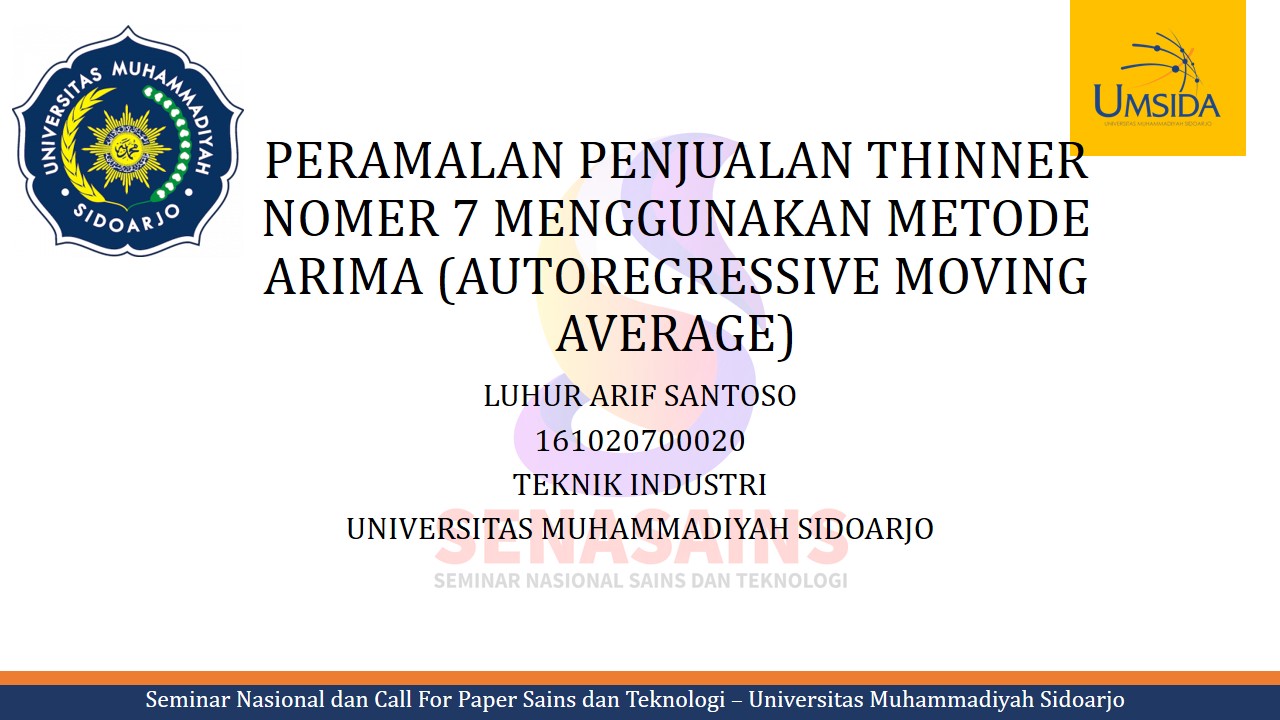Forecasting Thinner Number 7 Sales Using ARIMA (Autoregressive Integrated Moving Average) Method
Peramalan Penjualan Thinner Nomor 7 Menggunakan Metode ARIMA (Autoregressive Integrated Moving Average)
DOI:
https://doi.org/10.21070/pels.v2i2.1281Keywords:
ARIMA Box-Jenkins’s Model, Forecasting, Stock, Stock on HandAbstract
PT. DCN Indonesia is a paint distributor company. In the provision of paint and all devices including thinner often require a keepatan in its provider. This research is done to obtain thinner demand forecasting and determine the amount of stock that must be available in storage in order to at any time meet the impromptu demand that is one of the problems. ARIMA is a forecasting method that is suitable for such cases because it has advantages in the use of data with fluctuating patterns. The results achieved in this study got the ARIMA model (1, 0, 4) which means that the forecasting results are influenced by the results of observations one month ago san error four months ago. obtained the results of the sale of thinner of 8 liters and after going through the calculation of safety stock resulted in inventory planning calculations of 120 liters.
Downloads
References
A. H. Nasution, "Perencanaan dan Pengendalian Produksi", Jakarta: PT. Candimas Metropole, 1999.
A.Khasib, "Pengaruh Variasi Penggunaan Thinner Pada Campuran Cat Terhadap Kualitas Hasil Pengecatan", JPTM. Vol. 06 , No. 01, pp. 35-42, 2017.
D. A. Purnamasari, “Model Agen untuk Peramalan Permintaan retailer menggunakan metode Double Exponential Smoothing (Studi Kasus : Distributor Toko Gamis di Batam),” vol. 6, no. 1, pp. 44-52, 2017.
D. Ispriyanti, "Pemodelan Statistika Dengan Transformasi Box Cox", Jurnal Matematika Dan Komputer , Vol. 7 , No. 3, pp. 8 - 17, 2004.
Makridakis, "Metode dan Aplikasi Peramalan", Jakarta: Erlangga, 2009.
M. G. N. Ihsan, “Analisa Peramalan Permintaan Produk Pipa PVC AW1/2'' SC 4M pada PT. WDJ”, Jurnal Integra, vol. 4, no. 1, pp. 63-72, 2014.
M. L. Tauryawati, “Perbandingan Metode Fuzzy Time Series Cheng dan Metode Box-Jenkins untuk memprediksi IHSG”, Sains dan Seni Pomits, vol. 3, no. 2, 2014.
R. R. Elvierayani, "Peramalan Nilai Tukar (Kurs) Rupiah Terhadap Dolar Tahun 2017 dengan Menggunakan Metode Arima Box-Jenkins", vol.1, no.1, pp. 253-261, 2017.
S. Santoso, "Metode Peramalan bisnis masa kini dengan minitab dan SPSS", Jakarta: PT. Elex Media Komputindo, 2009.
Suliyanto, "Ekonometrika Terapan-Teori dan Aplikasi dengan SPSS", Jakarta: CV. Andi Offset, 2011.




